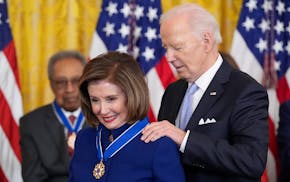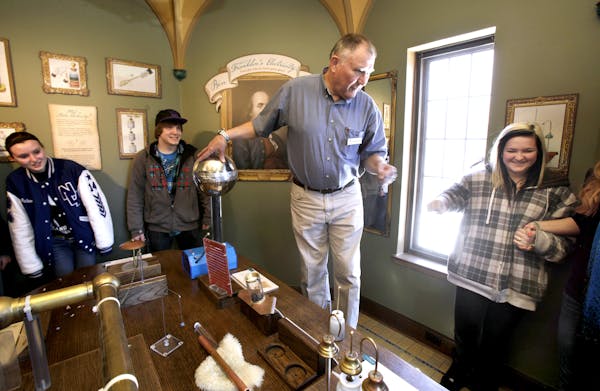A family of four visiting the Science Museum of Minnesota could spend nearly $50 just to get in the door. But a drop-in at the Minneapolis Institute of Arts (MIA) would cost them nothing. What's up with that?
It's not that dinosaur bones cost more than Monet paintings.
Museum admission fees vary wildly for all sorts of reasons and, not surprisingly, they're a hot topic in the field. History, institutional psychology and other factors come into play in deciding about how much, if anything, to charge. Most museums rely on a mix of endowment income, government funding and corporate and private donations to cover their basic costs. Admission fees fill in where those sources fall short. And many places that offer free admission, including the MIA, tack on charges for special shows.
The institute, which dropped general admission fees 25 years ago, was a pioneer in the "free" museum camp, although it's not alone. Many museums in Washington, D.C., are free, as are the Dallas Museum of Art, the Cincinnati Art Museum and the Kimbell Art Museum in Fort Worth, Texas.
Elsewhere, however, hefty fees are common. In San Francisco, the Exploratorium science center charges $25 for adults. New York's Museum of Modern Art also charges $25, while the Metropolitan Museum of Art "recommends" entry donations of that amount. In Chicago, the Art Institute charges adults $23, and the Field Museum charges $18.
"I'd never worked for a free museum before I came here and always thought you have to charge because people value what they pay for," said Kaywin Feldman, the MIA's executive director since 2008. "But I've completely changed my mind and now think that you have to be free to be accessible."
The MIA's policy is deeply rooted. When the museum opened in 1915, its bylaws required it to be "free of charge" at least three days per week including Sundays. A special Hennepin County tax was even set up to help cover its operating costs. That fund last year generated $10.9 million, or more than one-third of the museum's budget.
To ensure access regardless of income, most museums have regular free days or evenings. And virtually all of them offer discounts to children, students, senior citizens and people who have bought a museum membership.
Dallas freebies
Dallas Museum of Art director Maxwell Anderson became a provocative advocate of the free policy when he abolished that institution's admission charges in 2013 and followed up with free membership in 2014.
He argues that counting on admission fees to balance budgets warps priorities by prompting museums to overbuild their facilities and book commercially appealing shows designed to boost ticket sales rather than to enrich cultural appreciation. Such tactics may work in big, tourist-heavy cities such as New York and Los Angeles, he observed, but often disappoint in the heartland.
Memberships also may intimidate the uninitiated, he said.
"If you're a new visitor unaccustomed to museums and someone asks if you're a member, that's not very welcoming and makes it seem as if we're a club," Anderson said in a recent interview. "We museums look like banks or fancy clubs. We're forbidding and intimidating to the public who don't regularly go to museums. So this is a way of calling the question on the economic model we've all been espousing for a generation and that I think is broken."
Dallas museumgoers who sign up for a free membership earn perks by taking tours, "liking" their favorite art works on social media and participating in other programs. Perks range from free parking and shop discounts to an overnight stay in the museum or lunch with the director.
More than 60,000 people have joined for free in the past year, and an additional 15,000 signed on to a "partners" program for which they pay an average of about $330 annually. That generated $3.6 million for the museum in 2013, just a bit below the $3.9 million it took in from 19,000 traditional members the previous year. Most important, the 75,000 members offer gold mines of data about their taste in art, food, shopping and more.
The MIA, along with museums in Denver and Los Angeles, will try some of these ideas over the next two years thanks to a $450,000 grant.
Paying to play
Like the MIA, the Science Museum in St. Paul relies on various "revenue streams" to cover its $40 million annual budget. It gets $1.2 million in state funding but counts on admission tickets to cover a substantial chunk of operating costs. It charges $12 for regular adult gallery admission and up to $28 for special shows with Imax movie features, such as its current "Ultimate Dinosaurs" exhibit.
Last year the museum's tickets and fees, including classes and summer camps, brought in $4.6 million. That helps pay for research, educational programs and new shows. The 2013 Maya exhibit, which was researched and built in St. Paul, cost $4 million to produce. While those costs were shared by partner institutions in Denver, Boston and San Diego, admission fees were essential in recouping the museums' investment.
Fees do not appear to have discouraged visitors. The museum's tally of 644,000 visitors last year was close to that of the "free" MIA, which drew a record 680,000 people, many of whom paid extra to see special shows of Rembrandt paintings or Chinese terra-cotta warriors.
"A family of four going to the Science Museum will see things they can't find anyplace else," spokeswoman Kim Ramsden said. "They can learn about the Mississippi or make music together on the musical stairs or put their hands through a tornado. So a visit here creates lasting memories that are, I think, well worth the price of admission."
Walker Art Center likewise counts on its $14 gallery admission fee — which generates $350,000 to $450,000 annually — to help balance its $19 million operating budget. The adjacent Minneapolis Sculpture Garden remains free.
The Minnesota History Center in St. Paul began charging admission in 2005 after a substantial cut in state funding. At first, the museum tried to squeak by with reduced hours, but focus groups indicated that people would rather pay than lose access to the center. It now charges $11, generating about $400,000 toward its $55.1 million operating costs. It received $33.4 million last year from the state.
Ironically, the recent financial crisis sparked some beneficial changes. Unable to afford the all-Minnesota exhibitions that were its mainstay, the History Center began renting occasional national shows that attracted new visitors. It invested more in marketing and audience research, and attendance is up. Last year, of the 807,000 visitors to the Historical Society's 26 museums and historic sites around the state, about 185,000 toured the History Center's galleries.
"Museums are just expensive places to run, and none that I know of can be run on admission costs alone," said Dan Spock, the History Center's director. "There is a cost for keeping this kind of amenity going in your community, and, I think, by and large people accept that."
Mary Abbe • 612-673-4431

Helen Simonson is in Jane Austen mode with 'The Hazelbourne Ladies Motorcycle and Flying Club'
New Orleans' own PJ Morton returns home to Jazz Fest with new music

Biden awards the Medal of Freedom to Nancy Pelosi, Medgar Evers, Michelle Yeoh and 15 others
![Mia's former associate curator of Native American Art Jill Ahlberg Yohe.
] ELIZABETH FLORES • liz.flores@startribune.com](https://arc.stimg.co/startribunemedia/KLM6KWE7YJDQRICKFBZ3QEYRPA.jpg?h=91&w=145&fit=crop&bg=999&crop=faces)
